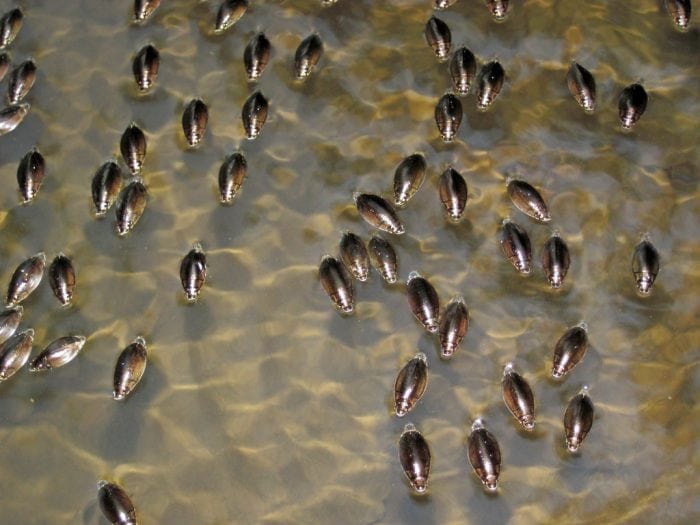
A well-known paper in literature (Roberts, 1997, Animal Behaviour, 54:1517-1522) asks the important question: “How many birds does it take to put a flock to flight?” The question could apply to any group of organisms from birds, buffalo, insects, people, and perhaps even cells. It is important to understand how groups of animals behave so that we may catch them, avoid them, or perhaps prevent them from trampling each other.
The number it takes to “put a flock to flight” is not a trivial one. For a given species it might be one, a fixed number, or a fixed percentage. Then we could ask whether there is some constancy, a rule across species, or perhaps a pattern in this number for given situations. For example, might there be one ratio of motivated/unmotivated animals when avoiding predators, but another number for motivating the rest of the group to move for foraging purposes?
Surprisingly little information is known about these questions. It is difficult to do controlled experiments on this problem, where you know exactly how many individuals initially move. Several animal studies have suggested a number between 5 and 15% of individuals moving in one direction is needed to trigger a full-group response. However, these studies did not test different group sizes. Additionally, simulation studies of groups using individually based models have also addressed lower and upper thresholds for the number of knowledgeable individuals in a group to steer the group.
To test “how many animals it takes to put a group to flight,” the authors of a recent study worked with an animal system in which vision could be manipulated and the group response to a predator stimulus could be carefully measured. Specifically, they changed the ratio of sighted to unsighted animals in groups of different sizes. The object of their study were whirligig beetles (Gyrinidae), one-centimeter-long aquatic beetles that swim at the surface of lakes and rivers.
The advantages of using this animal to address the question are that they exist in nature in a variety of different group sizes, in groups of non-relatives, and they have four sets of eyes. The extra eyes were helpful for the experiment because the researchers could obstruct the ones pointing upwards (responsible for detecting the predator) while leaving the lower eyes alone, so the beetles could see each other and perform their evasive maneuver called a “flash expansion.”
A flash expansion is a stereotyped predator-avoidance response in which grouped animals move quickly away from each other, maintain a rapid speed for several seconds while circling, then just as quickly, slow down and regroup at the same location. The adaptive function of a flash expansion is to make it difficult for predators to focus on one individual in a group before striking. Fish and birds are predators of whirligig beetles.
In the laboratory, in pools of water with a camera suspended over them, the researchers created three different group sizes of whirligigs: 12, 24, and 48. To test if it was the absolute number that was important, the researchers assembled these groups with one, two, three, or four sighted beetles in a group that was otherwise composed of unsighted beetles. Alternatively, to test if it was the proportion that was important, they assembled groups where 5%, 8%, 12%, and 17% beetles were sighted in a group of otherwise unsighted beetles.
After exposing each of the groups of whirligigs to a simulated predator attack, they then analyzed video to determine what percentage of each group reacted. A full group response was where all of the members of the group responded in a stereotyped flash expansion; the sighted beetles were able to stimulate all the unsighted beetles to join in the “stampede.” Partial responses involving 50 or 75% of the members of the group also occurred, in which the sighted beetles stimulated some of the other beetles to swim quickly, but it never escalated into a full-group response.
Romey and Kemak found that it took more sighted beetles to stimulate a full-group response in larger groups than in smaller groups. Specifically, their results supported the proportional hypothesis; the threshold for a full response was approximately 10% in each of the group sizes. So, with a firm grasp on the threshold for one species, its number and that it is proportional, there remain all of the rest of the grouping species in the world to examine. This is an example of how basic research on an esoteric species, like a whirligig, may point towards a general trend and way of testing other animals with more ecological and anthropogenic gravitas.
Future confirmation or rejection of this newly discovered 10% rule in whirligigs may be helpful in predicting animal movement patterns. If such a rule exists, it could be helpful in crowd control. For example, it would be useful to know how many individuals in a group need to know where the exit doors are in a stadium in order to exit efficiently. Or, if such a rule also occurs in cells, one could try to investigate how many cells in a tumor or a neuron were needed to behave in a certain way in order to get the rest of the individuals to follow. In summary, there is still much to be understood in “how many ‘birds’ it takes to put a flock to flight.” But, as a first approximation in one species, the answer seems to be 10%.
These findings are described in the article entitled Is the quorum threshold for emergent group responses in whirligigs absolute or proportional, recently published in the journal Animal Behaviour. This work was conducted by W.L. Romey and C. Kemak from the State University of New York at Potsdam.









